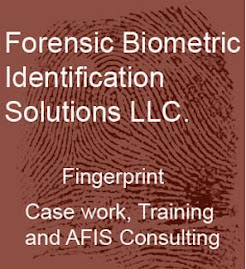One of theme that runs through most of my blogs is the importance of having fingerprint evidence evaluated by a fingerprint expert. In theory this is a reasonable request, but practically, it may be cost prohibitive. An alternative is to have someone in the office receive the same basic training that a fingerprint expert would receive. The trained individual while not an expert would e the knowledge to evaluate a fingerprint case and:
know when to contract a fingerprint expert.
know if all the fingerprints were searched properly.
understand the importance of unidentified latents.
The training would be invaluable for a prosecutor or defense attorney's office. A course has been developed by FBIS-LLC available on-line in mid-January, that would offer the flexibility required to allow someone from a busy attorney's office to complete this type of fingerprint training. The training program is similar to what a new fingerprint examiner would receive at the state or federal level. Since the course is on-line there are no set hours of attendance or timetable for completion.
I also want to point out the training could be used by state and local law enforcement agencies and student's (criminal justice and para-legal programs), as a a basic fingerprint training course, with the ability to utilize the training in an agency remediation program. If you have any questions please visit our website http://www.fingerprintconsultingservices.com/ or contact us at fbis@cox.net
Bob McAuley
Dir. Operations/Training
Forensic Biometric Identification Solutions LLC.
Monday, December 21, 2009
Sunday, December 13, 2009
A Review of the FBI's Handling of the Brandon Mayfield Case #4 application of the 1 discrepancy rule
As every examiner knows, latent and exemplar images are never exactly the same. The reasons are many; how the exemplar was recorded or where the latent was deposited, etc. The experienced examiner during the analysis and evaluation must be able to understand and explain any discrepant points found in either the latent or examplar images. In this case we had experienced examiners determine the discrepant points of identification were the result of latent distortion, probably caused by the bag. The examiners made a subjective determination which was incorrect. The panel noted theFBI examiners failed to follow the 1 discrepancy rule , if there is 1 unexplainable discrepancy in either the latent or exemplar image an individualization cannot be made. In this case the examiners did re-evaluate the prints and tried to get the Spanish examiners to agree with the FBI examiners individualization, I don't think they ignored the rule , they felt they could explain the discrepancies. The examiners would have given the Spanish examiners their interpretation of reasons for he discrepant points.
The thing to remember is if highly skilled and experienced examiners, which each of these examiners is can make this type of mistake, what about the less skilled and experienced examiners. Most individualization's are done by examiners with much less experience and training than the FBI examiners. Currently the most effective prevention is for the defense or court to have the fingerprint evidence re-evaluated by an unbiased 3r party.
Bob McAuley
Dir. Operations/Training
Forensic Biometric Identification Solutions LLC.
The thing to remember is if highly skilled and experienced examiners, which each of these examiners is can make this type of mistake, what about the less skilled and experienced examiners. Most individualization's are done by examiners with much less experience and training than the FBI examiners. Currently the most effective prevention is for the defense or court to have the fingerprint evidence re-evaluated by an unbiased 3r party.
Bob McAuley
Dir. Operations/Training
Forensic Biometric Identification Solutions LLC.
Saturday, December 5, 2009
A Review of the FBI's Handling of the Brandon Mayfield Case;Problem #3 Faulty reliance on Level III Detail
In the Mayfield case the FBI examiners increased the total minutiae they felt they had from 10 points of Level II detail to 15 total points utilizing level III detail. Level III detail can include a number of things from ridge shape and pores to scars and this information can be beneficial in individualization when properly used. It would appear that they continued the " circular reasoning " utilizing the level III detail. The examiners justified the the ten level II points based on the level III detail; ridge shape,pore placement and incipient dots. While I did not see the original images, from what I was able to see, the latent lacked clarity. On poor quality images it is very difficult to obtain reliable level III detail, the such small ridge characteristics are usually compromised by background clutter and distortion. The FBI had several different copies of Mayfields know prints and some of the level III detail was not present in all the copies, which should have caused the examiners concern. While level III detail can be helpful, it becomes less helpful as clarity decreases. I want to emphasize how important it is to utilizie multiple copies of an inked image if they are available when working poor quality images.
Bob McAuley
Dir. Operations/Training
Forensic Biometric Identification Solutions LLC.
Bob McAuley
Dir. Operations/Training
Forensic Biometric Identification Solutions LLC.
Subscribe to:
Comments (Atom)






